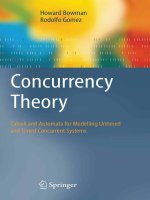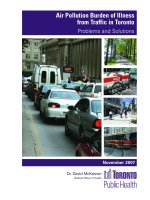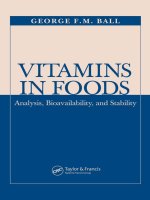Flavonoids and Related Compounds: Bioavailability and Function potx
Bạn đang xem bản rút gọn của tài liệu. Xem và tải ngay bản đầy đủ của tài liệu tại đây (16.71 MB, 474 trang )
FLAVONOIDS AND
RELATED COMPOUNDS
Bioavailability and Function
OXIDATIVE STRESS AND DISEASE
Series Editors
Lester Packer, PhD
Enrique Cadenas, MD, PhD
University of Southern California School of Pharmacy
Los Angeles, California
1. Oxidative Stress in Cancer, AIDS, and Neurodegenerative
Diseases, edited by Luc Montagnier, René Olivier, and Catherine
Pasquier
2. Understanding the Process of Aging: The Roles of Mitochondria,
Free Radicals, and Antioxidants, edited by Enrique Cadenas
and Lester Packer
3. Redox Regulation of Cell Signaling and Its Clinical Application,
edited by Lester Packer and Junji Yodoi
4. Antioxidants in Diabetes Management, edited by Lester Packer,
Peter Rösen, Hans J. Tritschler, George L. King, and Angelo Azzi
5. Free Radicals in Brain Pathophysiology, edited by Giuseppe
Poli, Enrique Cadenas, and Lester Packer
6. Nutraceuticals in Health and Disease Prevention, edited by
Klaus Krämer, Peter-Paul Hoppe, and Lester Packer
7. Environmental Stressors in Health and Disease, edited by
Jürgen Fuchs and Lester Packer
8. Handbook of Antioxidants: Second Edition, Revised and
Expanded, edited by Enrique Cadenas and Lester Packer
9. Flavonoids in Health and Disease: Second Edition, Revised and
Expanded, edited by Catherine A. Rice-Evans and Lester Packer
10. Redox–Genome Interactions in Health and Disease, edited by
Jürgen Fuchs, Maurizio Podda, and Lester Packer
11. Thiamine: Catalytic Mechanisms in Normal and Disease States,
edited by Frank Jordan and Mulchand S. Patel
12. Phytochemicals in Health and Disease, edited by Yongping Bao
and Roger Fenwick
13. Carotenoids in Health and Disease, edited by Norman I. Krinsky,
Susan T. Mayne, and Helmut Sies
14. Herbal and Traditional Medicine: Molecular Aspects of Health,
edited by Lester Packer, Choon Nam Ong, and Barry Halliwell
15. Nutrients and Cell Signaling, edited by Janos Zempleni
and Krishnamurti Dakshinamurti
16. Mitochondria in Health and Disease, edited by Carolyn D. Berdanier
17. Nutrigenomics, edited by Gerald Rimbach, Jürgen Fuchs,
and Lester Packer
18. Oxidative Stress, Inflammation, and Health, edited by
Young-Joon Surh and Lester Packer
19. Nitric Oxide, Cell Signaling, and Gene Expression, edited by
Santiago Lamas and Enrique Cadenas
20. Resveratrol in Health and Disease, edited by Bharat B. Aggarwal
and Shishir Shishodia
21. Oxidative Stress and Age-Related Neurodegeneration, edited by
Yuan Luo and Lester Packer
22. Molecular Interventions in Lifestyle-Related Diseases, edited by
Midori Hiramatsu, Toshikazu Yoshikawa, and Lester Packer
23. Oxidative Stress and Inflammatory Mechanisms in Obesity,
Diabetes, and the Metabolic Syndrome, edited by Lester Packer
and Helmut Sies
24. Lipoic Acid: Energy Production, Antioxidant Activity and Health
Effects, edited by Mulchand S. Patel and Lester Packer
25. Dietary Modulation of Cell Signaling Pathways, edited by
Young-Joon Surh, Zigang Dong, Enrique Cadenas,
and Lester Packer
26. Micronutrients and Brain Health, edited by Lester Packer,
Helmut Sies, Manfred Eggersdorfer, and Enrique Cadenas
27. Adipose Tissue and Inflammation, edited by Atif B. Awad
and Peter G. Bradford
28. Herbal Medicine: Biomolecular and Clinical Aspects, Second
Edition, edited by Iris F. F. Benzie and Sissi Wachtel-Galor
29. Flavonoids and Related Compounds: Bioavailability and
Function, edited by Jeremy P. E. Spencer and Alan Crozier
FLAVONOIDS AND
RELATED COMPOUNDS
Bioavailability and Function
Edited by
JEREMY P. E. SPENCER • ALAN CROZIER
Boca Raton London New York
CRC Press is an imprint of the
Taylor & Francis Group, an informa business
CRC Press
Taylor & Francis Group
6000 Broken Sound Parkway NW, Suite 300
Boca Raton, FL 33487-2742
© 2012 by Taylor & Francis Group, LLC
CRC Press is an imprint of Taylor & Francis Group, an Informa business
No claim to original U.S. Government works
Printed in the United States of America on acid-free paper
Version Date: 20120210
International Standard Book Number: 978-1-4398-4826-5 (Hardback)
This book contains information obtained from authentic and highly regarded sources. Reasonable efforts
have been made to publish reliable data and information, but the author and publisher cannot assume
responsibility for the validity of all materials or the consequences of their use. The authors and publishers
have attempted to trace the copyright holders of all material reproduced in this publication and apologize to
copyright holders if permission to publish in this form has not been obtained. If any copyright material has
not been acknowledged please write and let us know so we may rectify in any future reprint.
Except as permitted under U.S. Copyright Law, no part of this book may be reprinted, reproduced, transmitted, or utilized in any form by any electronic, mechanical, or other means, now known or hereafter invented,
including photocopying, microfilming, and recording, or in any information storage or retrieval system,
without written permission from the publishers.
For permission to photocopy or use material electronically from this work, please access www.copyright.
com ( or contact the Copyright Clearance Center, Inc. (CCC), 222 Rosewood
Drive, Danvers, MA 01923, 978-750-8400. CCC is a not-for-profit organization that provides licenses and
registration for a variety of users. For organizations that have been granted a photocopy license by the CCC,
a separate system of payment has been arranged.
Trademark Notice: Product or corporate names may be trademarks or registered trademarks, and are used
only for identification and explanation without intent to infringe.
Library of Congress Cataloging‑in‑Publication Data
Flavonoids and related compounds : bioavailability and functions / editors, Jeremy P.E.
Spencer, Alan Crozier.
p. ; cm. -- (Oxidative stress and disease ; 29)
Includes bibliographical references and index.
ISBN 978-1-4398-4826-5 (hardcover : alk. paper)
I. Spencer, Jeremy P.E. II. Crozier, Alan. III. Series: Oxidative stress and disease ; 29.
[DNLM: 1. Flavonoids. 2. Biological Availability. W1 OX626 v.29 2012 / QU 220]
572’.2--dc23
Visit the Taylor & Francis Web site at
and the CRC Press Web site at
2012005189
In memory of James A. Joseph (1944–2010): unconventional
thinker, pioneer in nutritional neuroscience, inspirational
speaker, caring mentor, generous scientist, outdoor adventurer,
entertaining friend to many, and a shining example to us all.
Contents
Series Preface ............................................................................................................xi
Preface.................................................................................................................... xiii
Editors ...................................................................................................................... xv
Contributors ...........................................................................................................xvii
Chapter 1
Bioavailability of Flavanones ...............................................................1
Mireia Urpi-Sarda, Joseph Rothwell, Christine Morand,
and Claudine Manach
Chapter 2
Bioavailability of Dietary Monomeric and Polymeric Flavan-3-ols ...... 45
Alan Crozier, Michael N. Clifford, and Daniele Del Rio
Chapter 3
Anthocyanins: Understanding Their Absorption and Metabolism......79
Ronald L. Prior
Chapter 4
Bioavailability of Flavonols and Flavones ......................................... 93
Mariusz Konrad Piskula, Kaeko Murota, and Junji Terao
Chapter 5
Bioavailability of Isoflavones in Humans ........................................ 109
Aedín Cassidy, José Palvo, and Peter Hollman
Chapter 6
Dietary Hydroxycinnamates and Their Bioavailability ................... 123
Angelique Stalmach, Gary Williamson, and Michael N. Clifford
Chapter 7
Bioavailability of Dihydrochalcones ................................................ 157
Elke Richling
Chapter 8
Occurrence, Bioavailability, and Metabolism of Resveratrol .......... 167
Paola Vitaglione, Stefano Sforza, and Daniele Del Rio
Chapter 9
Bioavailability and Metabolism of Ellagic Acid and
Ellagitannins................................................................................. 183
Mar Larrosa, María T. García-Conesa, Juan C. Espín,
and Francisco A. Tomás-Barberán
ix
x
Contents
Chapter 10 Colon-Derived Microbial Metabolites of Dietary Phenolic
Compounds....................................................................................... 201
Anna-Marja Aura
Chapter 11 Synthesis of Dietary Phenolic Metabolites and Isotopically
Labeled Dietary Phenolics ............................................................... 233
Denis Barron, Candice Smarrito-Menozz, René Fumeaux,
and Florian Viton
Chapter 12 Interactions of Flavan-3-ols within Cellular Signaling Pathways......281
Cesar G. Fraga and Patricia I. Oteiza
Chapter 13 Flavonoids and Vascular Function ................................................... 295
Ana Rodriguez-Mateos and Jeremy P.E. Spencer
Chapter 14 Effects of Flavonoids on the Vascular Endothelium: What Is
Known and What Is Next? ...............................................................309
Antje R. Weseler and Aalt Bast
Chapter 15 Green Tea Flavan-3-ols and Their Role in Protecting against
Alzheimer’s and Parkinson’s Disease Pathophysiology ................... 331
Orly Weinreb, Tamar Amit, Moussa B.H. Youdim,
and Silvia Mandel
Chapter 16 Flavonoids and Neuroinflammation ................................................. 363
David Vauzour and Katerina Vafeiadou
Chapter 17 Effects of Flavonoids on Cognitive Performance ............................ 393
Shibu M. Poulose and Barbara Shukitt-Hale
Chapter 18 Flavonoids and Oral Cancer ............................................................. 413
Thomas Walle
Chapter 19 Flavonoids and Cancer—Effects on DNA Damage ......................... 425
Piyawan Sitthiphong, Annett Klinder, Johanna W. Lampe,
and Ian Rowland
Index ......................................................................................................................445
Series Preface
Through evolution, oxygen—itself a free radical—was chosen as the terminal electron acceptor for respiration; hence, the formation of oxygen-derived free radicals is
a consequence of aerobic metabolism. These oxygen-derived radicals are involved
in oxidative damage to cell components inherent in several pathophysiological situations. Conversely, cells convene antioxidant mechanisms to counteract the effects of
oxidants by either a highly specific manner (e.g., superoxide dismutases) or in a less
specific manner (e.g., through small molecules, such as glutathione, vitamin E, and
vitamin C). Oxidative stress—as classically defined—entails an imbalance between
oxidants and antioxidants. However, the same free radicals that are generated during
oxidative stress are produced during normal metabolism and, as a corollary, are
involved in both human health and disease by virtue of their involvement in the
regulation of signal transduction and gene expression, activation of receptors and
nuclear transcription factors, antimicrobial and cytotoxic actions of immune system
cells, as well as in aging and age-related degenerative diseases.
In recent years, the research disciplines interested in oxidative stress have increased
our knowledge of the importance of the cell redox status and the recognition of
oxidative stress as a process with implications for many pathophysiological states.
From this multi- and interdisciplinary interest in oxidative stress emerges a concept
that attests to the vast consequences of the complex and dynamic interplay of oxidants
and antioxidants in cellular and tissue settings. Consequently, our view of oxidative
stress is growing in scope and new future directions. Likewise, the term reactive
oxygen species, adopted at some stage to highlight nonradical/radical oxidants, now
fails to reflect the rich variety of other species in free radical biology and medicine, encompassing nitrogen-, sulfur-, oxygen-, and carbon-centered radicals. These
reactive species are involved in the redox regulation of cell functions and, as a corollary, oxidative stress is increasingly viewed as a major upstream component in cell
signaling cascades involved in inflammatory responses, stimulation of cell adhesion
molecules, and chemoattractant production and as an early component in age-related
neurodegenerative disorders, such as Alzheimer’s, Parkinson’s, and Huntington’s
diseases, and amyotrophic lateral sclerosis. Hydrogen peroxide is probably the most
important redox signaling molecule that, among others, can activate NFκB, Nrf2,
and other universal transcription factors and is involved in the redox regulation of
insulin- and MAPK-signaling. These pleiotropic effects of hydrogen peroxide are
largely accounted for by changes in the thiol/disulfide status of the cell, an important
determinant of the redox status of the cell with clear involvement in adaptation, proliferation, differentiation, apoptosis, and necrosis.
The identification of oxidants in regulation of redox cell signaling and gene
expression was a significant breakthrough in the field of oxidative stress: the classical definition of oxidative stress as an imbalance between the production of oxidants
and the occurrence of antioxidant defenses now seems to provide a limited depiction
of oxidative stress, but it emphasizes the significance of cell redox status. Because
xi
xii
Series Preface
individual signaling and control events occur through discrete redox pathways rather
than through global balances, a new definition of oxidative stress was advanced by
Dean P. Jones as a disruption of redox signaling and control that recognizes the occurrence of compartmentalized cellular redox circuits. These concepts are anticipated
to serve as platforms for the development of tissue-specific therapeutics tailored to
discrete, compartmentalized redox circuits. This, in essence, dictates principles of
drug development–guided knowledge of mechanisms of oxidative stress. Hence, successful interventions will take advantage of new knowledge of compartmentalized
redox control and free radical scavenging.
Virtually all diseases thus far examined involve free radicals. In most cases, free
radicals are secondary to the disease process, but in some instances causality is
established by free radicals. Thus, there is a delicate balance between oxidants and
antioxidants in health and diseases. Their proper balance is essential for ensuring
healthy aging. Compelling support for the involvement of free radicals in disease
development originates from epidemiological studies showing that enhanced antioxidant status is associated with reduced risk of several diseases. Of great significance is the role played by micronutrients in the modulation of cell signaling. This
establishes a strong linking of diet and health and disease centered on the abilities of
micronutrients to regulate redox cell signaling and modify gene expression.
Oxidative stress is an underlying factor in health and disease. In this series of
books, the importance of oxidative stress and diseases associated with organ systems
is highlighted by exploring the scientific evidence and clinical applications of this
knowledge. This series is intended for researchers in the basic biomedical sciences
and clinicians. The potential of such knowledge for healthy aging and disease prevention warrants further knowledge about how oxidants and antioxidants modulate
cell and tissue function.
Flavonoids and Related Compounds: Bioavailability and Function edited
by Alan Crozier (University of Glasgow) and Jeremy P.E. Spencer (University of
Reading) is an authoritative treatise that reports updated information on the bioavailability, absorption, and metabolism of several flavonoids and polyphenols, their
effect on cell signaling pathways, and their role in vascular function, neurodegeneration (Alzheimer’s and Parkinson’s disease), and cancer. The number of flavonoids
and polyphenols recognized to date is staggering, and the editors have focused on
those with promising functions in health and disease in light of the current knowledge concerning their bioavailability and basic biological mechanisms of action.
Alan Crozier and Jeremy Spencer, internationally recognized leaders in the field of
dietary flavonoids, are congratulated for this excellent and timely book.
Lester Packer
Enrique Cadenas
Preface
Representing one of the most important lifestyle factors, diet can strongly influence
the incidence and onset of cardiovascular disease and neurodegenerative disorders.
Recent dietary intervention studies in several mammalian species, including humans,
with flavonoid-rich foods, in particular Vitis vinifera (grape), Camellia sinensis (tea),
Theobroma cacao (cocoa), and Vaccinium spp. (blueberry), have indicated an ability
of these dietary components to improve memory and learning. While these foods
and beverages differ greatly in chemical composition, macro- and micronutrient
content and caloric load per serving, they have in common that they are among the
major dietary sources for a group of phytochemicals called flavonoids and related
phenolic compounds. There is now a wealth of information to suggest that these
compounds exert a multiplicity of biological effects in humans, including beneficial
actions on the cardiovascular system, various effects on the brain, and a range of
activities against cancer development. However, even though there is extensive
evidence for their beneficial effects, there are still question marks over the extent of
their absorption, the degree of their metabolism, and their precise mechanisms of
action in vivo.
The book begins by examining the current knowledge regarding the absorption,
metabolism, and bioavailability of individual flavonoids and phenolic subgroups.
Individual chapters summarize the current thinking with regard to the biotransformation and conjugation of individual compounds in the gastrointestinal tract,
liver, large intestine, and cells. In particular, the extent to which dietary phenolics
components undergo metabolism in the large intestine, which has been largely
ignored to date, is highlighted as is the generation of potentially novel bacterially
derived metabolites. These individual chapters highlight which metabolites enter the
circulatory system and likely mediate protective actions against the various human
diseases.
Historically, the biological actions of flavonoids and related (poly)phenolic
compounds were attributed to their ability to exert antioxidant actions. However,
it is now thought highly unlikely that this classical hydrogen-donating antioxidant
activity accounts for the bioactivity of these compounds in vivo. Instead, evidence
has accumulated that the cellular effects are mediated by interactions with specific
proteins central to intracellular signaling cascades. Several chapters of the book
examine the latest evidence for the beneficial actions of flavonoids against various
human pathological conditions, including cardiovascular disease, neurodegeneration,
and cancer, and strive to provide logical and scientifically valid augments for how
such protective effects are mediated.
Overall, the book provides an excellent overview for anyone interested in the
bioavailability and biological function of a range of flavonoids relevant to a wide
array of plant-based foods.
xiii
Editors
Jeremy P. E. Spencer, PhD, received his doctorate from King’s College London in
1997 and is currently professor of nutritional medicine at the University of Reading.
His initial work focused on the cellular and molecular mechanisms underlying
neuronal death in Parkinson’s and Alzheimer’s diseases. His recent interests concern
how flavonoids influence brain health through their interactions with specific
cellular signaling pathways pivotal in protecting against neurotoxins, in preventing
neuroinflammation and in controlling memory, learning, and neurocognitive
performance.
Alan Crozier, PhD, graduated from the University of Durham in the United
Kingdom and after completing postgraduate studies at the University of London,
he moved to a postdoctoral position at the University of Calgary in Alberta. He then
lectured at the University of Canterbury in Christchurch, New Zealand, before transferring to the University of Glasgow where until recently he was professor of plant
biochemistry and human nutrition. He is currently a senior research fellow and has
published more than 250 papers and edited eight books. He has carried out research
on plant hormones and purine alkaloids, but the focus of his activities is now in the
field of dietary flavonoids and phenolics. His research group has extensive national
and international collaborations, with especially strong links to colleagues in Japan,
Italy, France, the United States, and Malaysia. Their research is focused principally
on teas, coffee, fruit juices, and wines, and the absorption and metabolism of a
diversity of potentially protective polyphenolic compounds in the body following
the ingestion of these beverages by humans—topics that are covered in depth in the
first 11 chapters of this book.
xv
Contributors
Tamar Amit, PhD
Department of Pharmacology
Technion Faculty of Medicine
Haifa, Israel
Anna-Marja Aura, DSc
VTT Technical Research Centre
of Finland
Espoo, Finland
Denis Barron, PhD
Nestlé Institute of Health Sciences
Lausanne, Switzerland
Aalt Bast, PhD
Department of Toxicology
Faculty of Health,
Medicine and Life Sciences
Maastricht University
Maastricht, the Netherlands
Aedín Cassidy, PhD
Department of Nutrition
Norwich Medical School
University of East Anglia
Norwich, United Kingdom
Michael N. Clifford, PhD
Centre for Nutrition and
Food Safety
Faculty of Health and
Medical Sciences
University of Surrey
Guildford, United Kingdom
Alan Crozier, PhD
School of Medicine
College of Medical,
Veterinary and Life Sciences
University of Glasgow
Glasgow, United Kingdom
Daniele Del Rio, PhD
The φ2 Laboratory of
Phytochemicals in Physiology
Human Nutrition Unit
Department of Public Health
University of Parma
Parma, Italy
Juan C. Espín, PhD
CEBAS-CSIC
Espinardo (Murcia), Spain
Cesar G. Fraga, PhD
Physical Chemistry-PRALIB
School of Pharmacy and Biochemistry
University of Buenos Aires-CONICET
Buenos Aires, Argentina
and
Department of Nutrition
University of California
Davis, California
René Fumeaux, PhD
Nestlé Research Center
Lausanne, Switzerland
María T. García-Conesa, PhD
CEBAS-CSIC
Espinardo (Murcia), Spain
Peter Hollman, PhD
Division of Nutrition
RIKILT
Wageningen, the Netherlands
Annett Klinder, PhD
Hugh Sinclair Unit of Human Nutrition
Department of Food and
Nutritional Sciences
University of Reading
Reading, United Kingdom
xvii
xviii
Johanna W. Lampe, PhD, RD
Cancer Prevention Research
Program
Public Health Sciences Division
Fred Hutchinson Cancer
Research Center
Seattle, Washington
Mar Larrosa, PhD
CEBAS-CSIC
Espinardo (Murcia), Spain
Claudine Manach, PhD
INRA UMR1019
Auvergne University
Clermont-Ferrand, France
Silvia Mandel, PhD
Department of Pharmacology
Technion Faculty of Medicine
Haifa, Israel
Christine Morand, PhD
INRA UMR1019
Auvergne University
Clermont-Ferrand, France
Kaeko Murota, PhD
Department of Life Science
Faculty of Science and
Engineering
Kinki University
Higashi-Osaka, Japan
Patricia I. Oteiza, PhD
Department of Nutrition and
Department of Environmental
Toxicology
University of California
Davis, California
José Peñalvo, PhD
Department of Epidemiology
CNIC
Madrid, Spain
Contributors
Mariusz Konrad Piskula, PhD
Division of Food Science
Institute of Animal Reproduction and
Food Research
Polish Academy of Sciences
Olsztyn, Poland
Shibu M. Poulose, PhD
USDA-ARS
Jean Mayer Human Nutrition
Research Center on Aging
Tufts University
Boston, Massachusetts
Ronald L. Prior, PhD (Retired)
Searcy, Arkansas
Elke Richling, PhD
Department of Chemistry
Food Chemistry and Toxicology
University of Kaiserslautern
Kaiserslautern, Germany
Ana Rodriguez-Mateos, PhD
Molecular Nutrition Group
Department of Food and
Nutritional Sciences
School of Chemistry, Food and Pharmacy
University of Reading
Reading, United Kingdom
Joseph Rothwell, PhD
INRA UMR1019
Auvergne University
Clermont-Ferrand, France
Ian Rowland, PhD
Hugh Sinclair Unit of Human Nutrition
Department of Food and
Nutritional Sciences
University of Reading
Reading, United Kingdom
Stefano Sforza, PhD
Department of Organic and
Industrial Chemistry
University of Parma
Parma, Italy
xix
Contributors
Barbara Shukitt-Hale, PhD
USDA-ARS
Neuroscience Laboratory
Jean Mayer Human Nutrition
Research Center on Aging
Tufts University
Boston, Massachusetts
Piyawan Sitthiphong, PhD
Hugh Sinclair Unit of Human
Nutrition
Department of Food and
Nutritional Sciences
University of Reading
Reading, United Kingdom
Candice Smarrito-Menozz, PhD
Nestlé Research Center
Lausanne, Switzerland
Jeremy P.E. Spencer, PhD
Molecular Nutrition Group
School of Chemistry, Food and
Pharmacy
University of Reading
Reading, United Kingdom
Angelique Stalmach, PhD
College of Medical,
Veterinary and Life Sciences
University of Glasgow
Glasgow, United Kingdom
Junji Terao, PhD
Department of Food Science
Graduate School of Nutrition and
Bioscience
University of Tokushima
Tokushima, Japan
Francisco A. Tomás-Barberán, PhD
CEBAS-CSIC
Espinardo (Murcia), Spain
Mireia Urpi-Sarda, PhD
Department of Internal Medicine
Hospital Clinic
August Pi i Sunyer Biomedical
Research Institute (IDIBAPS)
Barcelona, Spain
and
CIBER 06/03: Fisiopatología de la
Obesidad y la Nutrición
Instituto de Salud Carlos III
Madrid, Spain
Katerina Vafeiadou, PhD
Hugh Sinclair Unit of Human
Nutrition
Department of Food and
Nutritional Sciences
University of Reading
Reading, United Kingdom
David Vauzour, PhD
Faculty of Medicine and Health
Sciences
Norwich Medical School
University of East Anglia
Norwich, United Kingdom
Paola Vitaglione, PhD
Department of Food Science
University of Napoli “Federico II,”
Portici, Italy
Florian Viton, PhD
Nestlé Research Center
Lausanne, Switzerland
Thomas Walle, PhD
Department of Pharmacology
Medical University of South Carolina
Charleston, South Carolina
Orly Weinreb, PhD
Department of Pharmacology
Technion Faculty of Medicine
Haifa, Israel
xx
Antje R. Weseler, PhD
Department of Toxicology
Faculty of Health,
Medicine and Life Sciences
Maastricht University
Maastricht, the Netherlands
Gary Williamson, PhD
Department of Food Science and
Nutrition
University of Leeds
Leeds, United Kingdom
Contributors
Moussa B.H. Youdim, PhD
Department of Pharmacology
Technion Faculty of Medicine
Haifa, Israel
1
Bioavailability of
Flavanones
Mireia Urpi-Sarda, Joseph Rothwell,
Christine Morand, and Claudine Manach
contents
1.1
1.2
Introduction ...................................................................................................... 1
Bioavailability of Flavanones ........................................................................... 3
1.2.1 Absorption of Flavanones ..................................................................... 3
1.2.2 Metabolism of Flavanones In Vivo .......................................................5
1.2.3 Microbial Metabolism ........................................................................ 14
1.2.4 Tissue Distribution.............................................................................. 18
1.3 Pharmacokinetics of Flavanones .................................................................... 21
1.3.1 Studies in Humans .............................................................................. 21
1.3.1.1 Effect of Food Processing and Matrix ................................. 37
1.3.2 Studies in Animals ............................................................................. 38
1.4 Conclusions ..................................................................................................... 39
Acknowledgments.................................................................................................... 39
References ................................................................................................................ 39
1.1
IntroductIon
Flavanones are a class of flavonoids found mainly in citrus fruits, although minor
amounts have also been detected in herbs, red wine, and tomatoes (Neveu et al. 2010).
Flavanones are widely consumed in Western countries. In the adult Spanish population, for instance, intake may reach 50 mg/day, or around 17% of the estimated total
flavonoid intake, which ranks them as the most consumed flavonoid sub-class after
proanthocyanidins (Zamora-Ros et al. 2010). Flavanone intakes of 14.4, 20.4, 22,
33.5, and 34.7 mg/day have also been reported in the United States, United Kingdom,
Finland, Greece, and Italy, respectively (Zamora-Ros et al. 2010).
Epidemiological and clinical studies have associated the consumption of citrus
fruits or juices with a lower risk of ischemic stroke and acute coronary events and
with an improvement of vascular function (Joshipura et al. 1999; Morand et al. 2011).
These beneficial effects of citrus products appear to be linked to their flavanone
content, even if they are also important sources of other dietary bioactives such as
vitamin C, vitamin B9, carotenoids, and organic acids. Convincing data from numerous animal studies suggest the involvement of dietary flavanones in lowering blood
lipids, reducing plasma markers of endothelial dysfunction, reducing atherosclerosis
1
2
Flavonoids and Related Compounds: Bioavailability and Function
plaque progression, and improving insulin sensitivity (Choe et al. 2001; Lee et al.
2001; Akiyama et al. 2009; Mulvihill et al. 2009, 2010; Chanet et al. 2011).
Flavanones are based on a diphenylpropane skeleton, two benzene rings (A and B)
connected by a saturated three-carbon chain forming a closed pyran ring with
the benzene A ring. An epoxide group is present at the C4 position (Figure 1.1).
Hesperetin and naringenin are the most common flavanones in fruits, and they are
usually conjugated to a glucose-rhamnose disaccharide at the 7-position, typically
rutinose or neohesperidose. Flavanone rutinosides are tasteless, whereas flavanone
neohesperidoside conjugates such as hesperetin-7-O-neohesperidoside (neohesperidin) from bitter orange (Citrus aurantium) and naringenin-7-O-neohesperidoside
(naringin) from grapefruit (Citrus paradisi) are intensely bitter (Tomás-Barberán
and Clifford 2000). By virtue of their abundance in citrus fruit, hesperetin and
naringenin conjugates are the most studied flavanones with regard to metabolism
and bioavailability.
This chapter provides an overview of the in vivo bioavailability of flavanones with
a particular focus on the flavanone metabolites identified in the biofluids of humans
and animals. A comprehensive understanding of the absorption, metabolism, and
circulating forms of these polyphenolic compounds will be crucial to assess the
mechanisms by which they exert bioactivity and will also open up the possibility
HO
B
O
A C
O
OH
O
HO
HO
HO O
OH
Naringenin
OH
HO
OH
O
HO
HO
Hesperetin
OH
O
O
HO
HO
OH
HO
O
Flavanone
FIGure 1.1
OCH 3
OH
HO
HO O
O
O
HO O
OH
Hesperetin-7-O-neohesperidoside
(neohesperidin)
OCH 3
OH
HO
HO
O
HO O
HO O
Eriodictyol
Homoeriodictyol
O
O
3'-Hydroxyflavanone
General structure of flavanones.
OCH3
O
O
O
HO
OH
O
HO O
OH
HO
HO
HO
O
OH
O
O
Naringenin-7-O-neohesperidoside
(naringin)
Hesperetin-7-O-rutinoside
(hesperidin)
OH
O
O
HO
HO O
O
O
O
HO
OH
OH
Liquiritigenin
OH
O
O
OCH3
O
O
O
Naringenin-7-O-rutinoside
(narirutin)
HO O
HO
O
HO
HO
OH
HO
HO
HO
O
HO O
Pinocembrin
OH
OH
O
O
4'-Hydroxyflavanone
HO
O
O
4',7-Dihydroxyflavanone
Bioavailability of Flavanones
3
of optimizing the nature and quantity of flavanone doses for possible protection
against disease.
1.2 BIoavaIlaBIlIty oF Flavanones
1.2.1 Absorption of flAvAnones
Flavanones are mainly present in foods as diglycosides. It has long been known that
such glycosides cannot be absorbed in their native form in the small intestine but
must by hydrolyzed by intestinal microflora before absorption of their aglycone moieties in the colon. The nature of the attached sugar moiety has been shown to be an
important determinant of the mode of absorption. The kinetics and efficiency of
absorption of isolated naringenin, naringenin-7-O-glucoside, and naringenin-7-Oneohesperidoside were compared in rats either after a single flavanone-containing
meal or after adaptation for 14 days to a supplemented diet (Felgines et al. 2000).
Similar kinetics and levels of absorption were reported for naringenin and naringenin-7-O-glucoside, but the time of the peak plasma concentration (Tmax) was
markedly delayed in the case of naringenin-7-O-neohesperidoside, reflecting an
absorption in more distal parts of the intestine. In humans, the absorption of aglycone
and glycosides has never been compared using pure compounds. However, several
intervention studies with citrus fruit juices, which mainly contain rutinosides and
hesperidosides, have consistently reported plasma Tmax times to be between 4.5 and
7 h, indicative of absorption in the colon (Erlund et al. 2001; Manach et al. 2003;
Gardana et al. 2007; Mullen et al. 2008a; Brett et al. 2009; Bredsdorff et al. 2010;
Cao et al. 2010; Vallejo et al. 2010).
Enzymes present in the small intestine are able to hydrolyze some flavonoid glucosides, but flavonoid rhamnoglucosides, such as naringenin-7-O-neohesperidoside,
are not hydrolyzed by cell-free extracts from the human small intestine (Day et al.
1998). Griffiths and Barrow (1972) revealed that the gut microbiota play a crucial
role in the release of flavanone aglycones from their glycosides. They showed that
naringenin-7-O-neohesperidoside and hesperetin-7-O-rutinoside (hesperidin) when
administered to germ-free rats were recovered intact in feces, whereas low recoveries
were obtained from rats with a normal microflora. In support, a recent study found
that a 6-day pretreatment of rats with antibiotics markedly lowered the absorption
of hesperetin-7-O-rutinoside (Jin et al. 2011). The key enzymes required for hydrolysis and subsequent absorption of flavanone glycosides are α-l-rhamnosidases,
and several bacterial strains present in the human colon have been reported to produce α-l-rhamnosidases able to cleave flavonoid rutinosides and neohesperidosides
(Bokkenheuser et al. 1987; Yadav et al. 2010). In contrast to rutinosides and hesperidosides, flavanone glucosides are quite rare in foods. According to the web database Phenol-Explorer, naringenin-7-O-glucoside (prunin) is found in tomatoes and
almonds, and eriodictyol-7-O-glucoside is present in peppermint. Moreover, a number
of patented processes for the debittering of citrus fruit juices are based on the cleavage
of naringenin-7-O-neohesperidoside by α-l-rhamnosidases to produce the less bitter
glucoside naringenin-7-O-glucoside (Yadav et al. 2010). Such a process has been used
to compare the bioavailability in humans of flavanones from a natural orange juice and
4
Flavonoids and Related Compounds: Bioavailability and Function
an orange juice treated with hesperidinase to yield hesperetin-7-O-glucoside (Nielsen
et al. 2006). In a double-blind randomized cross-over study on 16 volunteers, the
conversion of the rutinose to a glucose group markedly improved the bioavailability of
hesperetin through the change of absorption site from the colon to the small intestine
(Nielsen et al. 2006). Plasma Tmax decreased from 7.0 ± 3.0 h to 0.6 ± 0.1 h, and correspondingly the peak plasma concentration (Cmax), the area under the plasma concentration versus time curve (AUC), and urinary excretion of hesperetin increased more than
3-fold. Similarly, Bredsdorff et al. (2010) compared the bioavailability of naringenin
from untreated orange juice, naturally rich in naringenin-7-O-rutinoside, to an orange
juice treated with α-rhamnosidase, abundant in naringenin-7-O-glucoside. Again, the
α-rhamnosidase treatment of the orange juice considerably increased the plasma AUC
and Cmax of naringenin (4- and 5.4-fold, respectively), whereas the Tmax fell from 311
to 92 min. The urinary excretion of naringenin increased from 7 to 47% of intake
after the α-rhamnosidase treatment. It is notable that the ingestion of flavanones as
glucosides instead of rutinosides increases bioavailability without changing the profile
of phase II metabolites (Bredsdorff et al. 2010). Because of the striking effectiveness
of converting natural diglycoside forms into glucosides to improve flavanone bioavailability, interest has been recently arisen in developing industrial applications for the
fermentation of food sources using Lactobacillus strains, which express rhamnosidases (Avila et al. 2009; Beekwilder et al. 2009).
The mechanisms involved in intestinal absorption of flavanones have been investigated using various in vitro systems and animal models. Several authors have studied the metabolism and transport of flavanones using cultured Caco-2 cells as an in
vitro model for the intestinal epithelium. This cell line exhibits many morphological and functional similarities to the normal human intestinal epithelial cells when
grown as polarized cells. Tourniaire et al. (2005) observed a very poor absorption
of naringenin-7-O-neohesperidoside by Caco-2 cells and suggested an involvement
of the P-glycoprotein (P-gp) transporter in effluxing the neohesperidoside back to
the apical side. Similarly, the permeation rate of hesperetin-7-O-rutinoside across
the Caco-2 cell monolayer was shown to be very low, and transport occurred via
a paracellular route (Kim et al. 1999; Kobayashi et al. 2008; Serra et al. 2008).
In contrast, Kobayashi et al. (2008) demonstrated that hesperetin was efficiently
absorbed, with a permeation rate 400-fold higher than for hesperitin-7-O-rutinoside.
The aglycone was reported to be absorbed via a transcellular route, by means of a
proton-coupled active transport Na+-independent transporter as well as passive diffusion, made possible by the small size and relatively high lipophilicity of hesperetin
(a log P of 2.55 predicted by ALOGPS computational method.). Londoño-Londoño
et al. (2010) reported that hesperetin had much stronger molecular interactions with
lipophilic membranes than hesperitin-7-O-rutinoside, in part due to the ability of
the aglycone to adopt a more planar conformation. Using the Caco-2 cell model,
Brand et al. (2008) investigated the metabolism of the aglycone hesperetin and the
role of ATP-binding cassette (ABC) transporters in the efflux of hesperetin and
its metabolites. Hesperetin was extensively metabolized in the Caco-2 cells to its
7-O-glucuronide (86% of the total metabolites) and 7-O-sulfate conjugates, which
were predominantly transported to the apical side but also, to a lesser extent, to
the basolateral side. Co-administration experiments with inhibitors of several ABC









